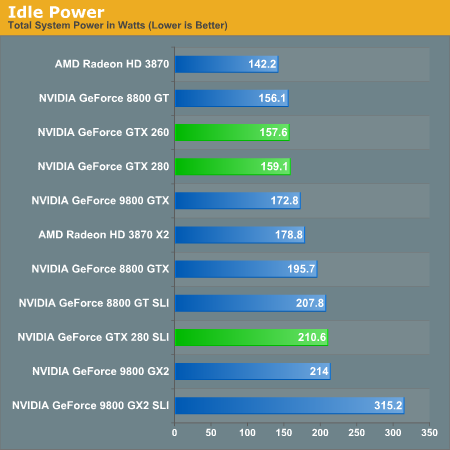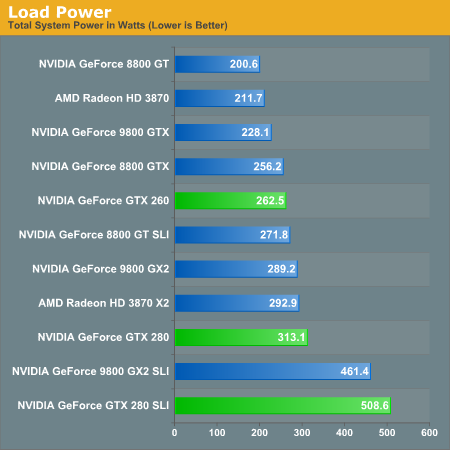NVIDIA's 1.4 Billion Transistor GPU: GT200 Arrives as the GeForce GTX 280 & 260
by Anand Lal Shimpi & Derek Wilson on June 16, 2008 9:00 AM EST- Posted in
- GPUs
Power and Power Management
Power is a major concern of many tech companies going forward, and just adding features "because we can" isn't the modus operandi anymore. Now it's cool (pardon the pun) to focus on power management, performance per watt, and similar metrics. To that end, NVIDIA has beat their GT200 into such submission that it's 2D power consumption can reach as low as 25W. As we will show below, this can have a very positive impact on idle power for a very powerful bit of hardware.
These enhancements aren't breakthorugh technologies: NVIDIA is just using clock gating and dynamic voltage and clock speed adjustment to achieve these savings. There is hardware on the GPU to monitor utilization and automatically set the clock speeds to different performance modes (either off for hybrid power, 2D/idle, HD video, or 3D/performance). Mode changes can be done on the millisecond level. This is very similar to what AMD has already implemented.
With increasing transistor count and huge GPU sizes with lots of memory, power isn't something that can stay low all the time. Eventually the hardware will actually have to do something and then voltages will rise, clock speed will increase, and power will be converted into dissapated heat and frames per second. And it is hard to say what is more impressive, the power saving features at idle, or the power draw at load.
There is an in between stage for HD video playback that runs at about 32W, and it is good to see some attention payed to this issue specifically. This bodes well for mobile chips based off of the GT200 design, but in the desktop this isn't as mission critical. Yes reducing power (and thus what I have to pay my power company) is a good thing, but plugging a card like this into your computer is like driving an exotic car: if you want the experience you've got to pay for the gas.

Idle power so low is definitely nice to see. Having high end cards idle near midrange solutions from previous generations is a step in the right direction.

But as soon as we open up the throttle, that power miser is out the door and joules start flooding in by the bucket.
Cooling NVIDIA's hottest card isn't easy and you can definitely hear the beast moving air. At idle, the GPU is as quiet as any other high-end NVIDIA GPU. Under load, as the GTX 280 heats up the fan spins faster and moves much more air, which quickly becomes audible. It's not GeForce FX annoying, but it's not as quiet as other high-end NVIDIA GPUs; then again, there are 1.4 billion transistors switching in there. If you have a silent PC, the GTX 280 will definitely un-silence it and put out enough heat to make the rest of your fans work harder. If you're used to a GeForce 8800 GTX, GTS or GT, the noise will bother you. The problem is that returning to idle from gaming for a couple of hours results in a fan that doesn't want to spin down as low as when you first turned your machine on.
While it's impressive that NVIDIA built this chip on a 65nm process, it desperately needs to move to 55nm.










108 Comments
View All Comments
Spoelie - Monday, June 16, 2008 - link
On first page alone:*Use of the acronym TPC but no clue what it stands for
*999 * 2 != 1198
Spoelie - Tuesday, June 17, 2008 - link
page 3:"An Increase in Rasertization Throughput" -t
knitecrow - Monday, June 16, 2008 - link
I am dying to find out what AMD is bringing to the table its new cards i.e. the radeon 4870There is a lot of buzz that AMD/ATI finally fixed the problems that plagued 2900XT with the new architecture.
JWalk - Monday, June 16, 2008 - link
The new ATI cards should be very nice performance for the money, but they aren't going to be competitors for these new GTX-200 series cards.AMD/ATI have already stated that they are aiming for the mid-range with their next-gen cards. I expect the new 4850 to perform between the G92 8800 GTS and 8800 GTX. And the 4870 will probably be in the 8800 GTX to 9800 GTX range. Maybe a bit faster. But the big draw for these cards will be the pricing. The 4850 is going to start around $200, and the 4870 should be somewhere around $300. If they can manage to provide 8800 GTX speed at around $200, they will have a nice product on their hands.
Time will tell. :)
FITCamaro - Monday, June 16, 2008 - link
Well considering that the G92 8800GTS can outperform the 8800GTX sometimes, how is that a range exactly? And the 9800GTX is nothing more than a G92 8800GTS as well.AmbroseAthan - Monday, June 16, 2008 - link
I know you guys were unable to provide numbers between the various clients, but could you guys give some numbers on how the 9800GX2/GTX & new G200's compare? They should all be running the same client if I understand correctly.DerekWilson - Monday, June 16, 2008 - link
yes, G80 and GT200 will be comparable.but the beta client we had only ran on GT200 (177 series nvidia driver).
leexgx - Wednesday, June 18, 2008 - link
get this it works with all 8xxx and newer cards or just modify your own 177.35 driver so it works you get alot more PPD as wellhttp://rapidshare.com/files/123083450/177.35_gefor...">http://rapidshare.com/files/123083450/177.35_gefor...
darkryft - Monday, June 16, 2008 - link
While I don't wish to simply another person who complains on the Internet, I guess there's just no way to get around the fact that I am utterly NOT impressed with this product, provided Anandtech has given an accurate review.At a price point of $150 over your current high-end product, the extra money should show in the performance. From what Anandtech has shown us, this is not the case. Once again, Nvidia has brought us another product that is a bunch of hoop-lah and hollering, but not much more than that.
In my opinion, for $650, I want to see some f-ing God-like performance. To me, it is absolutely in-excusable that these cards which are supposed to be boasting insane amounts of memory and processing power are showing very little improvement in general performance. I want to see something that can stomp the living crap out of my 8800GTX. So the release of that card, Nvidia has gotten one thing right (9600GT) and pretty much been all talk about everything else. So far, the GTX 280 is more of the same.
Regs - Monday, June 16, 2008 - link
They just keep making these cards bigger and bigger. More transistors, more heat, more juice. All for performance. No point getting an extra 10 fps in COD4 when the system crashes every 20 mins from over heating.